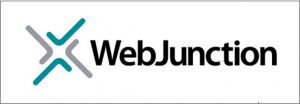Search the Blog
Categories
- Books & Reading
- Broadband Buzz
- Census
- Education & Training
- General
- Grants
- Information Resources
- Library Management
- Nebraska Center for the Book
- Nebraska Libraries on the Web
- Nebraska Memories
- Now hiring @ your library
- Preservation
- Pretty Sweet Tech
- Programming
- Public Library Boards of Trustees
- Public Relations
- Talking Book & Braille Service (TBBS)
- Technology
- Uncategorized
- What's Up Doc / Govdocs
- Youth Services
Archives
Subscribe
Author Archives: Mary Sauers
FREE PLA Webinar : Measuring the Success of Health Programs and Services
![]() Public libraries are critical to their community’s health, serving as a go-to resource for individuals to access current and reliable health information. Public library staff have a deep understanding of the unique needs of their communities and the value of serving their patrons’ health needs. Now all they need is the data to prove just how valuable those services are. In this webinar, participants will learn how Project Outcome’s new health survey will help public libraries measure the success of health programs and services. Participants will also discover helpful resources and training tools to enhance their health services. REGISTER NOW!
Public libraries are critical to their community’s health, serving as a go-to resource for individuals to access current and reliable health information. Public library staff have a deep understanding of the unique needs of their communities and the value of serving their patrons’ health needs. Now all they need is the data to prove just how valuable those services are. In this webinar, participants will learn how Project Outcome’s new health survey will help public libraries measure the success of health programs and services. Participants will also discover helpful resources and training tools to enhance their health services. REGISTER NOW!
The Project Outcome health survey was developed in partnership with the National Network of Libraries of Medicine (NNLM), dedicated to advancing the progress of medicine and improving public health. To learn more, visit https://nnlm.gov/.
At the conclusion of this webinar, participants will:
- Know resources and training tools to help create and improve health services at their library;
- Understand how to measure the outcomes of their health-related programs using Project Outcome’s new health survey; and,
- Be able to apply survey data for decision making and action.
Presenter:
Emily Plagman, manager of impact and advocacy, manages PLA’s performance measurement initiative, Project Outcome. Prior to joining PLA, Emily worked as a project manager at the Chicago Metropolitan Agency for Planning on an energy efficiency grant. Emily received her Master’s in International Public Affairs from the LaFollette School of Public Affairs at the University of Wisconsin and her Bachelor’s in Political Science at Marquette University.
REGISTRATION DETAILS:
Date: Wednesday, May 29, 2019
Time: 1:00–2:00 p.m. Central Time
Cost: The webinar is free, but registration is required. You can register for this webinar until it begins, or until space is no longer available, whichever comes first.
2020 Census: Key Roles for Libraries
 In 2020, the Census will be conducted primarily online for the first time. Like past e-government efforts, this will likely impact libraries and libraries’ technology resources as staff work to assist people in participating in the Census. The 2020 Census also presents an opportunity to increase public awareness and use of Census data. To best position libraries to support our communities in the 2020 Census, ALA is engaging with the Census Bureau and other stakeholders to ensure that libraries are informed and represented in the policy discussions and planning process. ALA is advocating for a fair, accurate, and inclusive Census that recognizes the roles libraries will play in this vital civic effort.
In 2020, the Census will be conducted primarily online for the first time. Like past e-government efforts, this will likely impact libraries and libraries’ technology resources as staff work to assist people in participating in the Census. The 2020 Census also presents an opportunity to increase public awareness and use of Census data. To best position libraries to support our communities in the 2020 Census, ALA is engaging with the Census Bureau and other stakeholders to ensure that libraries are informed and represented in the policy discussions and planning process. ALA is advocating for a fair, accurate, and inclusive Census that recognizes the roles libraries will play in this vital civic effort.
Want to stay up-to-date on our work to prepare for the 2020 Census? Subscribe to ALA’s Census newsletter.
Why the Census is Important
- Representation: The decennial count of all U.S. residents is required by the U.S. Constitution to determine representation in Congress and the Electoral College (known as reapportionment). This data is also the basis for drawing districts for federal, state, and local offices (known as redistricting).
- Funding: The Census is key to the allocation of billions of dollars in federal funding to states and localities (such as grants to states under the Library Services and Technology Act).
- Information: Data resulting from the Census is widely used by researchers, governments, businesses, and other organizations (to, for example, plan for library services).
Key Roles for Libraries
- Partners in E-Government: In 2020, the Census Bureau for the first time will encourage residents to complete the Census questionnaire online, starting in March 2020. Like past e-government efforts, this likely will place additional demands on library staff and technology resources to enable people to complete the Census questionnaire. (Other response methods will also be available.) Libraries can use their experience partnering with government to assist their communities in achieving a fair, accurate, and inclusive count.
- Education and Community Outreach: Libraries have the opportunity to educate their communities about the Census. In the 2010 Census, more than 6,000 library locations hosted Census Bureau outreach activities.
- Public Spaces: Census Bureau field staff often utilize community rooms in libraries as affordable temporary workspaces, such as for staff hiring and training. Other community stakeholders may also use library meeting rooms to host events related to the 2020 Census.
Advocacy for a Fair, Accurate, and Inclusive Census
- Coalition letter regarding to the Commerce, Justice, Science, and Related Agencies Appropriations subcommittees regarding FY2020 funding for the Census Bureau (April 16, 2019
- Testimony to the House Commerce Appropriations Subcommittee regarding funding for the 2020 Census (April 4, 2019)
- The Scoop: “ALA Joins Group Opposing Census Citizenship Question: Supreme Court Argument will be Heard April 23.” (April 2, 2019)
- Amicus curiae brief of ALA, et al., in the Supreme Court of the United States, Department of Commerce v. State of New York, regarding a citizenship question on the 2020 Census (April 1, 2019)
- Coalition letter to the U.S. Census Bureau on recommendations for Questionnaire Assistance Centers for the 2020 Census (March 19, 2019)
- Washington Hotline: “Libraries Can Ensure Everyone Counts in 2020 Census” (February, 2019)
- Letter to the U.S. Census Bureau regarding Questionnaire Assistance Centers for the 2020 Census (February 22, 2019)
- The Scoop: “Census Resources for Libraries: Help Achieve a Complete Count in 2020.” (January 15, 2019)
- Letter to the House and Senate Appropriations Committees urging funding for Questionnaire Assistance Centers in the 2020 Census (December 7, 2018)
- The Scoop: “Libraries and the 2020 Census: Workshops Prepare Librarians for Taking a Complete Count.” (October 30, 2018)
- The Scoop: “Getting Ready for the 2020 Census: Partnering with Complete Count Committees.” (September 11, 2018)
- The Scoop: “ALA Urges Commerce Department to Reject Census Citizenship Question.” (August 9, 2018)
- Comments to the Census Bureau regarding information collection in the 2020 Census (August 6, 2018)
- Coalition comments to the Census Bureau regarding information collection in the 2020 Census (August 1, 2018)
- Coalition Letter to the Senate Commerce, Justice, Science Appropriations Subcommittee regarding FY 2019 funding for the Census Bureau (June 4, 2018)
- District Dispatch: Gearing up for the 2020 Census (April 4, 2018)
- Coalition Letter to the House and Senate Commerce, Justice, Science Appropriations Subcommittees regarding FY 19 funding for the Census Bureau (May 1, 2018)
- Coalition Letters to the House Committee on Oversight and Government Reform and Senate Committee on Homeland Security and Governmental Affairs regarding a citizenship question on the 2020 Census (April 12, 2018)
- Coalition Letter to the Commerce Department opposing the addition of a citizenship question to the 2020 Census (January 10, 2018)
Learn More
- 2020 Census Technology FAQs – frequently asked technical and security questions regarding the 2020 census (CensusCounts.org)
- 2020 Census (U.S. Census Bureau)
- 2020 Census Operational Timeline (U.S. Census Bureau)
- Complete Count Committees (U.S. Census Bureau)
- Census Regional Offices – to contact the Census Bureau staff in your community (U.S. Census Bureau)
- Counting Everyone in the Digital Age: The Implications of Technology Use in the 2020 Decennial Census for the Count of Disadvantaged Groups (Leadership Conference Education Fund and Georgetown Center on Poverty and Inequality, Fall 2017)
- Census 2020 Hard to Count Map (City University of New York Center for Urban Research)
- Public libraries across the United States are planning to play an active role in the 2020 Census (City University of New York Center for Urban Research)
Courtesy of the American Library Association: http://www.ala.org/advocacy/govinfo/census
Countdown to the 2020 Census
 What Is the 2020 Census?
What Is the 2020 Census?
The 2020 Census counts every person living in the United States and five U.S. territories—once, only once, and in the right place. This census is conducted every 10 years by the U.S. Census Bureau, a nonpartisan government agency.
Why We Do It
The results of the census determine your congressional representation as well as federal funding for states and communities. Every year, more than $675 billion goes toward hospitals, fire departments, schools, roads, and more.
It’s also mandated by the Constitution: The United States has counted its population every 10 years since 1790.
When You Can Take the 2020 Census
By April 1, 2020, households will receive an invitation to participate in the 2020 Census. You’ll then have three ways to respond: online, by phone, or by mail.
You can find a detailed timeline for 2020 Census activities here.
And for the first time ever, you’ll be able to respond to the census online! Sign up below for a reminder to complete the 2020 Census.
Everyone Must Complete the 2020 Census
If you live in the United States, you are required by law to participate in the 2020 count, even if you recently completed another survey from the Census Bureau. A complete and accurate count is critical, as the results of the 2020 Census will affect congressional representation, community funding, and more.
Posted in Census, Education & Training, General, Information Resources, Technology, Uncategorized, What's Up Doc / Govdocs
Tagged census
Leave a comment
What’s Up Doc? New State Agency Publications at the Nebraska Library Commission
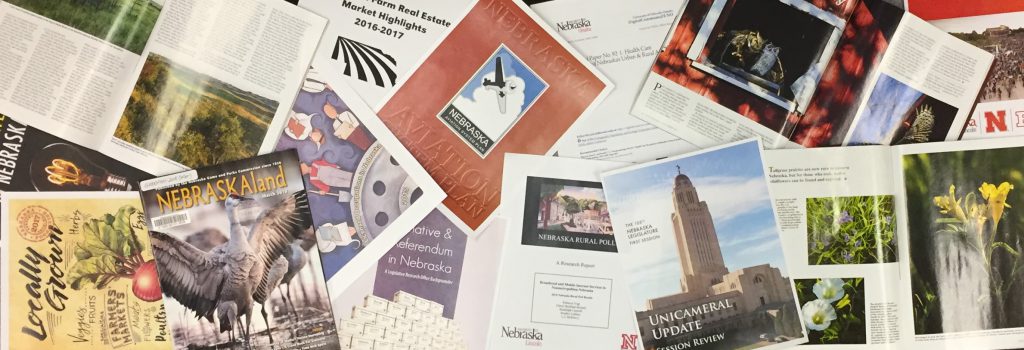 New state agency publications have been received at the Nebraska Library Commission for April 2019. Included are Annual Reports from a variety of Nebraska state agencies, reports from the Nebraska Library Commission, Nebraska Game and Parks Commission, Nebraska Foster Care Review Office, Nebraska Public Power District, Nebraska Department of Transportation, and new books from the University of Nebraska Press, to name a few.
New state agency publications have been received at the Nebraska Library Commission for April 2019. Included are Annual Reports from a variety of Nebraska state agencies, reports from the Nebraska Library Commission, Nebraska Game and Parks Commission, Nebraska Foster Care Review Office, Nebraska Public Power District, Nebraska Department of Transportation, and new books from the University of Nebraska Press, to name a few.
Most items, except the books from the University of Nebraska Press, are available for immediate viewing and printing by clicking on the highlighted link above, or directly in the .pdf below.
The Nebraska Legislature created the Nebraska Publications Clearinghouse in 1972, a service of the Nebraska Library Commission. Its purpose is to collect, preserve, and provide access to all public information published by Nebraska state agencies. By law (State Statutes 51-411 to 51-413) all Nebraska state agencies are required to submit their published documents to the Clearinghouse. For more information, visit the Nebraska Publications Clearinghouse page, contact Mary Sauers, Government Information Services Librarian; or contact Bonnie Henzel, State Documents Staff Assistant.
Book Briefs: New University of Nebraska Press Books at the Nebraska Publications Clearinghouse

The Nebraska Publications Clearinghouse receives documents every month from all Nebraska state agencies, including the University of Nebraska Press (UNP). Each month we will be showcasing the UNP books that the Clearinghouse receives. UNP books, as well as all Nebraska state documents, are available for checkout by libraries and librarians, for their patrons, in Nebraska.
Here are the UNP books the Clearinghouse received in April:
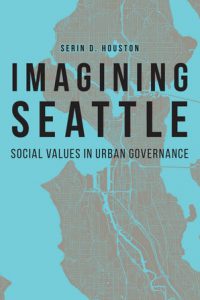
Imaging Seattle : Social Values in Urban Governance Serin D. Houston (Series: Our Sustainable Future)
Imagining Seattle dives into some of the most pressing and compelling aspects of contemporary urban governance in the United States. Serin D. Houston uses a case study of Seattle to shed light on how ideas about environmentalism, privilege, oppression, and economic growth have become entwined in contemporary discourse and practice in American cities. Seattle has, by all accounts, been hugely successful in cultivating amenities that attract a creative class. But policies aimed at burnishing Seattle’s liberal reputation often unfold in ways that further disadvantage communities of color and the poor, complicating the city’s claims to progressive politics.
Through ethnographic methods and a geographic perspective, Houston explores a range of recent initiatives in Seattle, including the designation of a new cultural district near downtown, the push to charge for disposable shopping bags, and the advent of training about institutional racism for municipal workers. Looking not just at what these policies say but at how they work in practice, she finds that opportunities for social justice, sustainability, and creativity are all constrained by the prevalence of market-oriented thinking and the classism and racism that seep into the architecture of many programs and policies. Houston urges us to consider how values influence actions within urban governance and emphasizes the necessity of developing effective conditions for sustainability, creativity, and social justice in this era of increasing urbanization.
Intersectionality : Origins, Contestations, Horizons Anna Carastathis 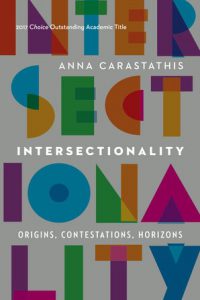 (Series: Expanding Frontiers)
(Series: Expanding Frontiers)
A 2017 Choice Outstanding Academic Title
Intersectionality intervenes in the field of intersectionality studies: the integrative examination of the effects of racial, gendered, and class power on people’s lives. While “intersectionality” tends to circulate merely as a buzzword, Anna Carastathis joins other critical voices in urging a more careful reading. Challenging the narratives of arrival that surround it, Carastathis argues that intersectionality is a horizon, illuminating ways of thinking that have yet to be realized; consequently, calls to “go beyond” intersectionality are premature. A provisional interpretation of intersectionality can disorient habits of essentialism, categorical purity, and prototypicality and overcome dynamics of segregation and subordination in political movements.
Through a close reading of critical race theorist Kimberlé Williams Crenshaw’s germinal texts, published more than twenty-five years ago, Carastathis urges analytic clarity, contextual rigor, and a politicized, historicized understanding of this pervasive concept. Intersectionality’s roots in social justice movements and critical intellectual projects—specifically black feminism—must be retraced and synthesized with a decolonial analysis so that its potential to actualize coalitions can be enacted.
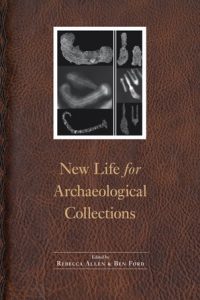 New Life for Archaeological Collections Edited by Rebecca Allen & Ben Ford (Society for Historical Archaeology Series in Material Culture)
New Life for Archaeological Collections Edited by Rebecca Allen & Ben Ford (Society for Historical Archaeology Series in Material Culture)
New Life for Archaeological Collections explores solutions to what archaeologists are calling the “curation crisis,” that is, too much stuff with too little research, analysis, and public interpretation. This volume demonstrates how archaeologists are taking both large and small steps toward not only solving the dilemma of storage but recognizing the value of these collections through inventorying and cataloging, curation, rehousing, artifact conservation, volunteer and student efforts, and public exhibits.
Essays in this volume highlight new questions and innovative uses for existing archaeological collections. Rebecca Allen and Ben Ford advance ways to make the evaluation and documentation of these collections more accessible to those inside and outside of the scholarly discipline of archaeology. Contributors to New Life for Archaeological Collections introduce readers to their research while opening new perspectives for scientists and students alike to explore the world of archaeology. These essays illuminate new connections between cultural studies and the general availability of archaeological research and information. Drawing from the experience of university professors, government agency professionals, and cultural resource managers, this volume represents a unique commentary on education, research, and the archaeological community.
Of Fathers and Fire : A Novel Steven Wingate (Series: Flyover Fiction) 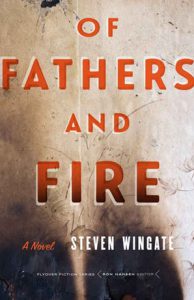
When Richie Thorpe and his ragtag religious band of ex-thieves arrive in the High Plains town of Suborney, Colorado, Tommy Sandor is captivated by the group. It’s the summer of 1980 in the dusty, junkyard town, and the seventeen-year-old is wrestling with the forces shaping America and himself: the Iran hostage crisis, the incoming tide of Ronald Reagan’s presidency, and the political rise of the Christian Right.
As Tommy is increasingly drawn to the group, his mother, Connie, grows frantic. She has been hiding the truth from her son, telling him that his father was a saxophonist from New York who never knew he had a child, and is lying low in Suborney to hide from Tommy’s actual father—Richie Thorpe. Connie knows Richie has come for his son, and though she has witnessed Thorpe’s mysterious powers, the desperation to protect her lie, her son, and their life begets a venom with an elemental power that threatens the whole town.
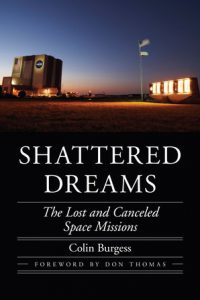 Shattered Dreams : The Lost and Canceled Space Missions Colin Burgess (Series: Outward Oddyssey : A People’s History of Spaceflight)
Shattered Dreams : The Lost and Canceled Space Missions Colin Burgess (Series: Outward Oddyssey : A People’s History of Spaceflight)
Shattered Dreams delves into the personal stories and recollections of several men and women who were in line to fly a specific or future space mission but lost that opportunity due to personal reasons, mission cancellations, or even tragedies. While some of the subjects are familiar names in spaceflight history, the accounts of others are told here for the first time. Colin Burgess features spaceflight candidates from the United States, Russia, Indonesia, Australia, and Great Britain.
Shattered Dreams brings to new life such episodes and upheavals in spaceflight history as the saga of the three Apollo missions that were cancelled due to budgetary constraints and never flew; NASA astronaut Patricia Hilliard Robertson, who died of burn injuries after her airplane crashed before she had a chance to fly into space; and a female cosmonaut who might have become the first journalist to fly in space. Another NASA astronaut was preparing to fly an Apollo mission before he was diagnosed with a disqualifying illness. There is also the amazing story of the pilot who could have bailed out of his damaged aircraft but held off while heroically avoiding a populated area and later applied to NASA to fulfill his cherished dream of becoming an astronaut despite having lost both legs in the accident.
These are the incredibly human stories of competitive realists fired with an unquenchable passion. Their accounts reveal in their own words—and those of others close to them—how their shared ambition would go awry through personal accidents, illness, the Challenger disaster, death, or other circumstances.
Unlikely Heroes : The Place of Holocaust Rescuers in Research and  Teaching Edited by Ari Kohen and Gerald J. Steinacher (Series: Contemporary Holocaust Studies)
Teaching Edited by Ari Kohen and Gerald J. Steinacher (Series: Contemporary Holocaust Studies)
Classes and books on the Holocaust often center on the experiences of victims, perpetrators, and bystanders, but rescuers also occupy a prominent space in Holocaust courses and literature even though incidents of rescue were relatively few and rescuers constituted less than 1 percent of the population in Nazi-occupied Europe. As inspiring figures and role models, rescuers challenge us to consider how we would act if we found ourselves in similarly perilous situations of grave moral import. Their stories speak to us and move us.
Yet this was not always the case. Seventy years ago these brave men and women, today regarded as the Righteous Among the Nations, went largely unrecognized; indeed, sometimes they were even singled out for abuse from their co-nationals for their selfless actions. Unlikely Heroes traces the evolution of the humanitarian hero, looking at the ways in which historians, politicians, and filmmakers have treated individual rescuers like Raoul Wallenberg and Oskar Schindler, as well as the rescue efforts of humanitarian organizations. Contributors in this edited collection also explore classroom possibilities for dealing with the role of rescuers, at both the university and the secondary level.
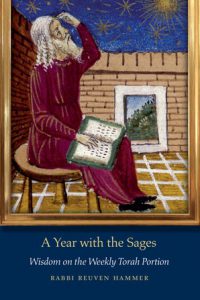 A Year With the Sages : Wisdom on the Weekly Torah Portion Rabbi Reuven Hammer (Series: JPS Daily Inspiration)
A Year With the Sages : Wisdom on the Weekly Torah Portion Rabbi Reuven Hammer (Series: JPS Daily Inspiration)
A Year with the Sages uniquely relates the Sages’ understanding of each Torah portion to everyday life. The importance of these teachings cannot be overstated. The Sages, who lived during the period from the fifth century BCE to the fifth century CE, considered themselves to have inherited the oral teachings God transmitted to Moses, along with the mandate to interpret them to each subsequent generation. Just as the Torah and the entire Hebrew Bible are the foundations of Judaism, the Sages’ teachings form the structures of Jewish belief and practice built on that foundation. Many of these teachings revolve around core concepts such as God’s justice, God’s love, Torah, Israel, humility, honesty, loving-kindness, reverence, prayer, and repentance.
You are invited to spend a year with the inspiring ideas of the Sages through their reflections on the fifty-four weekly Torah portions and the eleven Jewish holidays. Quoting from the week’s Torah portion, Rabbi Reuven Hammer presents a Torah commentary, selections from the Sages that chronicle their process of interpreting the text, a commentary that elucidates these concepts and their consequences, and a personal reflection that illumines the Sages’ enduring wisdom for our era.
Pictures and Synopses from the University of Nebraska Press website: https://www.nebraskapress.unl.edu/
Important FEMA Information for March 2019 Flooding
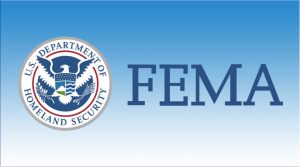 APPLYING FOR PUBLIC ASSISTANCE THROUGH FEMA AND NEMA
APPLYING FOR PUBLIC ASSISTANCE THROUGH FEMA AND NEMA
Cultural institutions and arts organizations in declared counties that were impacted by the March flooding may be eligible for Federal assistance via:
- Federal Emergency Management Agency (FEMA) Public Assistance (PA)
- Small Business Administration (SBA) disaster loans
If your organization or institution is affiliated with a government entity, such as a public university, you should communicate with that government entity regarding your damage and any expenditures (overtime of personnel, purchases, etc.) to protect your facilities. The information below doesn’t necessarily apply to your institution or organization because your expenditures will be included as part of your government entity – but only if that government entity is aware of your damage.
In a Nutshell: File, File, File
- File a claim with your insurance company immediately. Follow all the deadlines set by the insurance company, and submit all documents and information requested within the deadlines set by the insurance company. FEMA will want to see a settlement or denial letter from your insurance company to ensure that benefits are not duplicated, so be sure to file an insurance claim promptly. If you still have unmet needs or damages that the insurance company does not cover, then FEMA may be able to provide you with assistance.
- File for a Small Business Administration disaster loan as well. Complete and submit the application as soon as possible. The deadline to apply for an SBA Business Physical Disaster Loan is Mon., May 20. Submitting the application does not obligate you to accept an SBA loan, but it is a necessary step to being considered for other forms of federal disaster assistance, including FEMA Public Assistance. https://www.sba.gov/funding-programs/disaster-assistance
- File for FEMA Public Assistance. The deadline to apply for Public Assistance is Mon., May 20. After that date, the State and FEMA are not obligated to process your application. Go to Public Assistance page of the Nebraska Emergency Management Agency for information that includes a list of declared counties and the forms that need to be submitted: https://nema.nebraska.gov/recovery/public-assistance.
- For an explanation of the Public Assistance process via a virtual Applicant Briefing webinar, watch the YouTube video on that page.
Questions? Contact NEMA-PA at nema.publicassistance@nebraska.gov.
FREE 2019 Summer of Space Learning Program!
 In the summer of 2019, 16,000 libraries across the country will celebrate space exploration in their summer reading programs. The slogan “A Universe of Stories” was chosen by library professionals to help inspire children of all ages to dream big, believe in themselves, and create their own story. The Collaborative Summer Learning Program and STAR Net are partnering to share STEM resources with these libraries.
In the summer of 2019, 16,000 libraries across the country will celebrate space exploration in their summer reading programs. The slogan “A Universe of Stories” was chosen by library professionals to help inspire children of all ages to dream big, believe in themselves, and create their own story. The Collaborative Summer Learning Program and STAR Net are partnering to share STEM resources with these libraries.
This summer learning program will coincide with NASA’s 60 years of achievement and its celebration of the 50th anniversary of the Apollo 11 Moon Landing.
This is a free program funded primarily by NASA’s Science Mission Directorate. All giveaways, resources, and activities are available at no cost.
In order to participate, your library must be a public library within the United States and register at: https://www.surveymonkey.com/r/universe-of-stories-registration
The 2019 Summer of Space campaign does not require a paid subscription. You will, however, receive one newsletter a month highlighting resources.
You can register multiple libraries and branches in your system separately, providing an email address and point of contact for each.
The benefits of registering are: Access to STAR Net’s webinar series, a chance to win everything from a telescope, tactile books, and Scholastic books to NASA Stickers and calendars. New and exciting activities that connect well with A Universe of Stories and blogs highlighting events and competitions around the U.S.
Be sure to visit http://www.starnetlibraries.org/summer-of-space/ for more information and programming resources.
ALSO, SAVE THE DATE!
On Monday, July 15th, join us for a Live Webcast Event to celebrate the 50th anniversary of the Apollo 11 Mission. This live webcast, brought to you by the American Museum of Natural History, will feature a guided recreation of the Apollo 11 voyage – the space-flight that landed the first two astronauts on the Moon.
Note: More info will be available in future newsletters.
What’s Up Doc? New State Agency Publications at the Nebraska Library Commission
 New state agency publications have been received at the Nebraska Library Commission for March 2019. Included are reports from a variety of Nebraska state agencies: Nebraska Department of Agriculture, Nebraska Department of Economic Development, Nebraska Department of Natural Resources, Nebraska Public Power District, University of Nebraska-Omaha Center for Applied Urban Research, and new books from the University of Nebraska Press, to name a few.
New state agency publications have been received at the Nebraska Library Commission for March 2019. Included are reports from a variety of Nebraska state agencies: Nebraska Department of Agriculture, Nebraska Department of Economic Development, Nebraska Department of Natural Resources, Nebraska Public Power District, University of Nebraska-Omaha Center for Applied Urban Research, and new books from the University of Nebraska Press, to name a few.
Most items, except the books from the University of Nebraska Press, are available for immediate viewing and printing by clicking on the highlighted link above, or directly in the .pdf below.
The Nebraska Legislature created the Nebraska Publications Clearinghouse in 1972, a service of the Nebraska Library Commission. Its purpose is to collect, preserve, and provide access to all public information published by Nebraska state agencies. By law (State Statutes 51-411 to 51-413) all Nebraska state agencies are required to submit their published documents to the Clearinghouse. For more information, visit the Nebraska Publications Clearinghouse page, contact Mary Sauers, Government Information Services Librarian; or contact Bonnie Henzel, State Documents Staff Assistant.
Book Briefs: New University of Nebraska Press Books at the Nebraska Publications Clearinghouse

The Nebraska Publications Clearinghouse receives documents every month from all Nebraska state agencies, including the University of Nebraska Press (UNP). Each month we will be showcasing the UNP books that the Clearinghouse receives. UNP books, as well as all Nebraska state documents, are available for checkout by libraries and librarians, for their patrons, in Nebraska.
Here are the UNP books the Clearinghouse received in March:
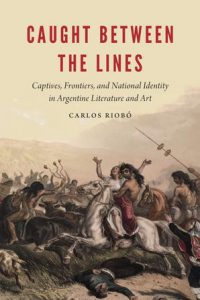 Caught Between the Lines Carlos Riobo (Series: New Hispanisms)
Caught Between the Lines Carlos Riobo (Series: New Hispanisms)
Caught between the Lines examines how the figure of the captive and the notion of borders have been used in Argentine literature and painting to reflect competing notions of national identity from the nineteenth to the twenty-first centuries. Challenging the conventional approach to the nineteenth-century trope of “civilization versus barbary,” which was intended to criticize the social and ethnic divisions within Argentina in order to create a homogenous society, Carlos Riobó traces the various versions of colonial captivity legends. He argues convincingly that the historical conditions of the colonial period created an ethnic hybridity—a mestizo or culturally mixed identity—that went against the state compulsion for a racially pure identity. This mestizaje was signified not only in Argentina’s literature but also in its art, and Riobó thus analyzes colonial paintings as well as texts.
Caught between the Lines focuses on borders and mestizaje (both biological and cultural) as they relate to captives: specifically, how captives have been used to create a national image of Argentina that relies on a logic of separation to justify concepts of national purity and to deny transculturation.
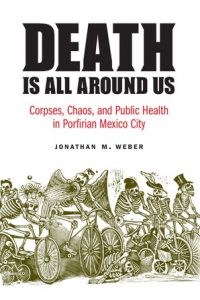
Death is All Around Us : Corpses, Chaos, and Public Health in Porfirian Mexico City Jonathan M. Weber (Series: The Mexican Experience)
Late nineteenth-century Mexico was a country rife with health problems. In 1876, one out of every nineteen people died prematurely in Mexico City, a staggeringly high rate when compared to other major Western world capitals at the time, which saw more modest premature death rates of one out of fifty-two (London), one out of forty-four (Paris), and one out of thirty-five (Madrid). It is not an exaggeration to maintain that each day dozens of bodies could be found scattered throughout the streets of Mexico City, making the capital city one of the most unsanitary places in the Western Hemisphere.
In light of such startling scenes, in Death Is All around Us Jonathan M. Weber examines how Mexican state officials, including President Porfirio Díaz, tried to resolve the public health dilemmas facing the city. By reducing the high mortality rate, state officials believed that Mexico City would be seen as a more modern and viable capital in North America. To this end the government used new forms of technology and scientific knowledge to deal with the thousands of unidentified and unburied corpses found in hospital morgues and cemeteries and on the streets. Tackling the central question of how the government used the latest technological and scientific advancements to persuade citizens and foreigners alike that the capital city—and thus Mexico as a whole—was capable of resolving the hygienic issues plaguing the city, Weber explores how the state’s attempts to exert control over procedures of death and burial became a powerful weapon for controlling the behavior of its citizens.
Ecology and Ethnogenesis : An Environmental History of the Wind River 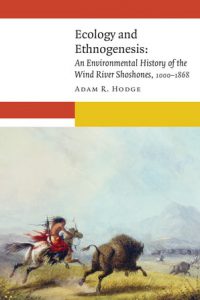 Shoshones, 1000-1868 Adam R. Hodge (Series: New Visions in Native American and Indigenous Studies)
Shoshones, 1000-1868 Adam R. Hodge (Series: New Visions in Native American and Indigenous Studies)
In Ecology and Ethnogenesis Adam R. Hodge argues that the Eastern Shoshone tribe, now located on the Wind River Reservation in Wyoming, underwent a process of ethnogenesis through cultural attachment to its physical environment that proved integral to its survival and existence. He explores the intersection of environmental, indigenous, and gender history to illuminate the historic roots of the Eastern Shoshone bands that inhabited the intermountain West during the nineteenth century.
Hodge presents an impressive longue durée narrative of Eastern Shoshone history from roughly 1000 CE to 1868, analyzing the major developments that influenced Shoshone culture and identity. Geographically spanning the Great Basin, Rocky Mountain, Columbia Plateau, and Great Plains regions, Ecology and Ethnogenesis engages environmental history to explore the synergistic relationship between the subsistence methods of indigenous people and the lands that they inhabited prior to the reservation era. In examining that history, Hodge treats Shoshones, other Native peoples, and Euroamericans as agents who, through their use of the environment, were major components of much broader ecosystems. The story of the Eastern Shoshones over eight hundred years is an epic story of ecological transformation, human agency, and cultural adaptation.
Ecology and Ethnogenesis is a major contribution to environmental history, ethnohistory, and Native American history. It explores Eastern Shoshone ethnogenesis based on interdisciplinary research in history, archaeology, anthropology, and the natural sciences in devoting more attention to the dynamic and often traumatic history of “precontact” Native America and to how the deeper past profoundly influenced the “postcontact” era.
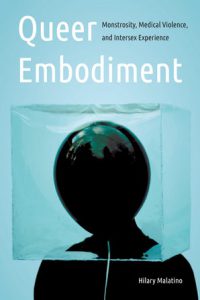 Queer Embodiment : Monstrosity, Medical Violence, and Intersex Experience Hilary Malatino (Series: Expanding Frontiers: Interdisciplinary Approaches to Studies of Women, Gender, and Sexuality)
Queer Embodiment : Monstrosity, Medical Violence, and Intersex Experience Hilary Malatino (Series: Expanding Frontiers: Interdisciplinary Approaches to Studies of Women, Gender, and Sexuality)
Merging critical theory, autobiography, and sexological archival research, Queer Embodiment provides insight into what it means, and has meant, to have a legible body in the West. Hilary Malatino explores how and why intersexuality became an anomalous embodiment requiring correction and how contesting this pathologization can promote medical reform and human rights for intersex and trans persons.
Malatino traces both institutional and interpersonal failures to dignify non–sexually dimorphic bodies and examines the ways in which the ontology of gender difference developed by modern sexologists conflicts with embodied experience. Malatino comprehensively shows how gender-normalizing practices begin at the clinic but are then amplified over time at both intimate and systemic levels, through mechanisms of institutional exclusion and through contemporary Eurocentric cultures’ cis-centric and bio-normative understanding of sexuality, reproductive capacity, romantic partnership, and kinship.
Combining personal accounts with archival evidence, Malatino presents intersexuality as the conceptual shibboleth of queerness, the figure through which nonnormative genders and desires are, and have been historically, understood. The medical, scientific, and philosophical discourse on intersexuality underlying our contemporary understanding of sexed selfhood requires theoretical and ethical reconsideration in order to facilitate understanding gender anew as an intra-active and continually differentiating process of becoming that exceeds and undoes restrictive binary logic.
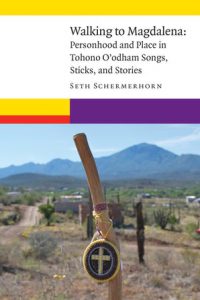 Walking to Magdalena : Personhood and Place in Tohono O’odham Songs, Sticks, and Stories
Walking to Magdalena : Personhood and Place in Tohono O’odham Songs, Sticks, and Stories
Seth Schermerhorn (Series: New Visions in Native American and Indigenous Studies)
In Walking to Magdalena, Seth Schermerhorn explores a question that is central to the interface of religious studies and Native American and indigenous studies: What have Native peoples made of Christianity? By focusing on the annual pilgrimage of the Tohono O’odham to Magdalena in Sonora, Mexico, Schermerhorn examines how these indigenous people of southern Arizona have made Christianity their own. This walk serves as the entry point for larger questions about what the Tohono O’odham have made of Christianity.
With scholarly rigor and passionate empathy, Schermerhorn offers a deep understanding of Tohono O’odham Christian traditions as practiced in everyday life and in the words of the O’odham themselves. The author’s rich ethnographic description and analyses are also drawn from his experiences accompanying a group of O’odham walkers on their pilgrimage to Saint Francis in Magdalena. For many years scholars have agreed that the journey to Magdalena is the largest and most significant event in the annual cycle of Tohono O’odham Christianity. Never before, however, has it been the subject of sustained scholarly inquiry.
Walking to Magdalena offers insight into religious life and expressive culture, relying on extensive field study, videotaped and transcribed oral histories of the O’odham, and archival research. The book illuminates indigenous theories of personhood and place in the everyday life, narratives, songs, and material culture of the Tohono O’odham.
Pictures and synopses courtesy of University of Nebraska Press.
Women Made Visible : Feminist Art and Media in Post-1968 Mexico City 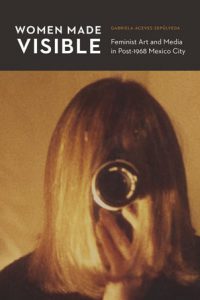 Gabriela Aceves Sepulveda (Series: The Mexican Experience)
Gabriela Aceves Sepulveda (Series: The Mexican Experience)
In post-1968 Mexico a group of artists and feminist activists began to question how feminine bodies were visually constructed and politicized across media. Participation of women was increasing in the public sphere, and the exclusive emphasis on written culture was giving way to audio-visual communications. Motivated by a desire for self-representation both visually and in politics, female artists and activists transformed existing regimes of media and visuality.
Women Made Visible by Gabriela Aceves Sepúlveda uses a transnational and interdisciplinary lens to analyze the fundamental and overlooked role played by artists and feminist activists in changing the ways female bodies were viewed and appropriated. Through their concern for self-representation (both visually and in formal politics), these women played a crucial role in transforming existing regimes of media and visuality—increasingly important intellectual spheres of action. Foregrounding the work of female artists and their performative and visual, rather than written, interventions in urban space in Mexico City, Aceves Sepúlveda demonstrates that these women feminized Mexico’s mediascapes and shaped the debates over the female body, gender difference, and sexual violence during the last decades of the twentieth century.
Weaving together the practices of activists, filmmakers, visual artists, videographers, and photographers, Women Made Visible questions the disciplinary boundaries that have historically undermined the practices of female artists and activists and locates the development of Mexican second-wave feminism as a meaningful actor in the contested political spaces of the era, both in Mexico City and internationally.
Pictures and Synopses from the University of Nebraska Press website: https://www.nebraskapress.unl.edu/
What’s Up Doc? New State Agency Publications at the Nebraska Library Commission
 New state agency publications have been received at the Nebraska Library Commission for January and February 2019. Included are reports from a variety of Nebraska state agencies: Nebraska State Board of Public Accountancy, Nebraska Department of Banking and Finance, Nebraska Public Power District, University of Nebraska-Lincoln Extension Service, University of Nebraska-Omaha Center for Applied Urban Research, and new books from the University of Nebraska Press, to name a few.
New state agency publications have been received at the Nebraska Library Commission for January and February 2019. Included are reports from a variety of Nebraska state agencies: Nebraska State Board of Public Accountancy, Nebraska Department of Banking and Finance, Nebraska Public Power District, University of Nebraska-Lincoln Extension Service, University of Nebraska-Omaha Center for Applied Urban Research, and new books from the University of Nebraska Press, to name a few.
Most items, except the books from the University of Nebraska Press, are available for immediate viewing and printing by clicking on the highlighted link above, or directly in the .pdf below.
The Nebraska Legislature created the Nebraska Publications Clearinghouse in 1972, a service of the Nebraska Library Commission. Its purpose is to collect, preserve, and provide access to all public information published by Nebraska state agencies. By law (State Statutes 51-411 to 51-413) all Nebraska state agencies are required to submit their published documents to the Clearinghouse. For more information, visit the Nebraska Publications Clearinghouse page, contact Mary Sauers, Government Information Services Librarian; or contact Bonnie Henzel, State Documents Staff Assistant.
Upcoming Webinars from WebJunction
Strategic Planning in a Deeply Weird World: The Flexible Roadmap Field Guide Approach
DATE AND TIME: Tuesday, March 26, 2019: 2:00-3:00 CENTRAL TIME
Join us to learn about Salt Lake City Public Library’s new ground-breaking approach to strategic planning, focused on human-centered service design.
It’s a big task to define the library’s future over the next three or five years, and strategic planning is becoming less and less effective in a rapidly changing world. The Salt Lake City Public Library (SLCPL) has created a new approach that is flexible, staff-driven, and human-centered. SCLPL’s Strategic Roadmap is not a 100-page plan in a binder-on-a-shelf; it’s an experiential learning tool that invites all staff to participate in the co-creation of meaningful outcomes and experiences for the community. The Roadmap focuses less on planning and more on building the capacity of staff to adopt a human-centered service design mindset and skillset. SLCPL staff are adopting a new perspective, continually experimenting with and adapting spaces, collections, services, programs, and their own roles, to responsively address community needs and aspirations in an ever-changing landscape. Join us for this webinar to learn how to cultivate new skills to help bring the Roadmap to life for your library’s strategic planning.
Presented by: Peter Bromberg, Executive Director; and Marilee Moon, Assistant Director of Customer Experience, at Salt Lake City Public Library
The Power of Small: How Rural Libraries Help Their Communities Thrive
DATE AND TIME: Thursday, April 18, 2019: 2:00-3:00 CENTRAL TIME
Learn how any tiny library can find more ways to support the needs of their community by thinking strategically and creating new connections.
All libraries provide vital services to their communities, but libraries that serve small, rural populations have the potential to go beyond providing information and access—they can inject the vitality that will help their communities thrive. Addressing the challenges faced by rural areas may seem daunting to a library with few staff and limited resources, but any tiny library can find more ways to support the needs of their community by thinking strategically and creating new connections with their stakeholders, patrons, and other library staff. Learn how small library director and 2018 Library Journal Mover & Shaker, Allie Stevens, applied the concept of growth mindsets to set her priorities, use resources and volunteers smartly, and avoid burnout as a solo librarian. Follow her lead to turn your library into a powerhouse for your community.
This webinar is presented in collaboration with the Association for Rural & Small Libraries.
Presented by: Allie Stevens, Director, Calhoun County Library & Museum, Hampton, Arkansas
The Library as Social Connector: Forging Community Connection
DATE AND TIME: Thursday, April 25, 2019: 2:00-3:00 CENTRAL TIME
This webinar will explore how libraries play a role in creating social connection and identify ways to more intentionally facilitate stronger community bonds.
Strong social cohesion is a crucial factor in a community’s resilience in times of stress and disruption. Unfortunately, studies show that our communities are experiencing a steady erosion of social cohesion, pointing to an increase in loneliness, depression, and separation because of too much time spent online and too little time spent in the community. Libraries have the position and the power to rebuild social bonds, offering that sense of community and shared place that humans crave. Active learning programs that bring people together for participatory, shared experiences are a boost to community strength, but they could go even further to amplify social connection and build social infrastructure. Join us as we explore library programs through the lens of social possibilities and devise strategies to be more intentional about forging stronger community bonds.
Presented by: Betha Gutsche, WebJunction Programs Manager, OCLC; and Jennifer Peterson, WebJunction Community Manager, OCLC
Book Briefs: New University of Nebraska Press Books at the Nebraska Publications Clearinghouse
 The Nebraska Publications Clearinghouse receives documents every month from all Nebraska state agencies, including the University of Nebraska Press (UNP). Each month we will be showcasing the UNP books that the Clearinghouse receives. The UNP books, as well as all Nebraska state documents, are available for checkout by libraries and librarians in Nebraska.
The Nebraska Publications Clearinghouse receives documents every month from all Nebraska state agencies, including the University of Nebraska Press (UNP). Each month we will be showcasing the UNP books that the Clearinghouse receives. The UNP books, as well as all Nebraska state documents, are available for checkout by libraries and librarians in Nebraska.
Here are the UNP books the Clearinghouse received in February:
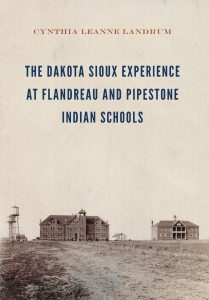 The Dakota Sioux Experience at Flandreau and Pipestone Indian Schools
The Dakota Sioux Experience at Flandreau and Pipestone Indian Schools
The Dakota Sioux Experience at Flandreau and Pipestone Indian Schools illuminates the relationship between the Dakota Sioux community and the schools and surrounding region, as well as the community’s long-term effort to maintain its role as caretaker of the “sacred citadel” of its people.
Cynthia Leanne Landrum explores how Dakota Sioux students at Flandreau Indian School in South Dakota and at Pipestone Indian School in Minnesota generally accepted the idea that they should attend these particular boarding institutions because they saw them as a means to an end and ultimately as community schools. This construct operated within the same philosophical framework in which some Eastern Woodland nations approached a non-Indian education that was simultaneously tied to long-term international alliances between Europeans and First Peoples beginning in the seventeenth and eighteenth centuries.
Landrum provides a new perspective from which to consider the Dakota people’s overt acceptance of this non-Native education system and a window into their ongoing evolutionary relationships, with all of the historic overtures and tensions that began the moment alliances were first brokered between the Algonquian Confederations and the European powers.
The Image of Elizabeth I in Early Modern Spain (Series: New Hispanisms)

Queen Elizabeth I was an iconic figure in England during her reign, with many contemporary English portraits and literary works extolling her virtue and political acumen. In Spain, however, her image was markedly different. While few Spanish fictional or historical writings focus primarily on Elizabeth, numerous works either allude to her or incorporate her as a character.
The Image of Elizabeth I in Early Modern Spain explores the fictionalized, historical, and visual representations of Elizabeth I and their impact on the Spanish collective imagination. Drawing on works by Miguel de Cervantes, Lope de Vega, Pedro de Ribadeneira, Luis de Góngora, Cristóbal de Virués, Antonio Coello, and Calderón de la Barca, among others, the contributors to this volume limn contradictory assessments of Elizabeth’s physical appearance, private life, personality, and reign. In doing so they articulate the various and sometimes conflicting ways in which the Tudor monarch became both the primary figure in English propaganda efforts against Spain and a central part of the Spanish political agenda.
This edited volume revives and questions the image of Elizabeth I in early modern Spain as a means of exploring how the queen’s persona, as mediated by its Spanish reception, has shaped the ways in which we understand Anglo-Spanish relations during a critical era for both kingdoms.

One Nation Under Baseball
One Nation Under Baseball highlights the intersection between American society and America’s pastime during the 1960s, when the hallmarks of the sport—fairness, competition, and mythology—came under scrutiny. John Florio and Ouisie Shapiro examine the events of the era that reshaped the game: the Koufax and Drysdale million-dollar holdout, the encroachment of television on newspaper coverage, the changing perception of ballplayers from mythic figures to overgrown boys, the arrival of the everyman Mets and their free-spirited fans, and the lawsuit brought against team owners by Curt Flood. One Nation Under Baseball brings to life the seminal figures of the era—including Bob Gibson, Marvin Miller, Tom Seaver, and Dick Young—richly portraying their roles during a decade of flux and uncertainty.
This Fish Is Fowl 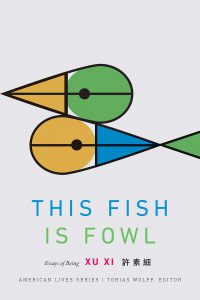 (Series: American Lives)
(Series: American Lives)
In this volume, Xu Xi offers the transnational and feminist perspective of a contemporary “glocalized” American life. Xu’s quirky, darkly comic, and obsessively personal essays emerge from her diverse professional career as a writer, business executive, entrepreneur, and educator. From her origins in Hong Kong as an Indonesian of Chinese descent to her U.S. citizenship and multiple countries of residence, she writes her way around the globe.
Caring for her mother with Alzheimer’s in Hong Kong becomes the rhythmic accompaniment to an enforced, long-term, long-distance relationship with her partner and home in New York. In between Xu reflects on all her selves, which are defined by those myriad monikers of existence. As an author who began life as a novelist and fiction writer, she also considers the nature of genre, which snakes its way through these essays. In her linguistic trip across the comic tragedy that is globalism, she wonders about the mystery of humanity and the future of our world at this complicated and precarious moment in human existence.
This Fish Is Fowl is a twenty-first-century blend of the essayist traditions of both West and East. Xu’s acerbic, deft prose shows her to be a descendant of both Michel de Montaigne and Lu Xun, with influences from stepparent Jonathan Swift.
 A Year with Mordecai Kaplan : Wisdom on the Weekly Torah Portion (Series: JPS Daily Inspiration)
A Year with Mordecai Kaplan : Wisdom on the Weekly Torah Portion (Series: JPS Daily Inspiration)
You are invited to spend a year with the inspirational words, ideas, and counsel of the great twentieth-century thinker Rabbi Mordecai Kaplan, through his meditations on the fifty-four weekly Torah portions and eleven Jewish holidays.
A pioneer of ideas and action—teaching that “Judaism is a civilization” encompassing Jewish culture, art, and peoplehood; demonstrating how synagogues can be full centers for Jewish living (building one of the first “shuls with a pool”); and creating the first-ever bat mitzvah ceremony (for his daughter Judith)—Kaplan transformed the landscape of American Jewry. Yet much of Kaplan’s rich treasury of ethical and spiritual thought is largely unknown.
Rabbi Steven Carr Reuben, who studied closely with Kaplan, offers unique insight into Kaplan’s teachings about ethical relationships and spiritual fulfillment, including how to embrace godliness in everyday experience, our mandate to become agents of justice in the world, and the human ability to evolve personally and collectively. Quoting from the week’s Torah portion, Reuben presents Torah commentary, a related quotation from Kaplan, a reflective commentary integrating Kaplan’s understanding of the Torah text, and an intimate story about his family or community’s struggles and triumphs—guiding twenty-first-century spiritual seekers of all backgrounds on how to live reflectively and purposefully every day.
Your Body is War (Series: African Poetry) 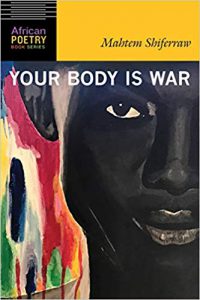
Your Body Is War contemplates the psychology of the female human body, looking at the ways it exists and moves in the world, refusing to be contained in the face of grief and trauma. Bold and raw, Mahtem Shiferraw’s poems explore what the woman’s body has to do to survive and persevere in the world, especially in the aftermath of abuse.
A groundbreaking collection, the poems in Your Body Is War embody elements of conflict, making them simultaneously a place of destruction and of freedom.
Pictures and synopses courtesy of University of Nebraska Press.
Friday Reads: The Bookman’s Tale: A Novel of Obsession, by Charlie Lovett
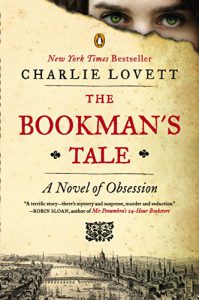 Mystery fiction has many subgenres: hard-boiled, cozy, police procedural, etc. One particular subgenre of interest to lovers of books is that of the bibliomystery, and in recent years, I’ve found that I love to read, or listen to, books that fall in this bibliomystery category. If you do an online search you will find many authors that write bibliomysteries. My favorites are John Dunning’s Cliff Janeway series, John Grisham’s Camino Island, Bradford Morrow’s Prague Sonata and bibliomysteries by Charlie Lovett, which leads me to today’s Friday Reads post: The Bookman’s Tale: A Novel of Obsession, by Charlie Lovett.
Mystery fiction has many subgenres: hard-boiled, cozy, police procedural, etc. One particular subgenre of interest to lovers of books is that of the bibliomystery, and in recent years, I’ve found that I love to read, or listen to, books that fall in this bibliomystery category. If you do an online search you will find many authors that write bibliomysteries. My favorites are John Dunning’s Cliff Janeway series, John Grisham’s Camino Island, Bradford Morrow’s Prague Sonata and bibliomysteries by Charlie Lovett, which leads me to today’s Friday Reads post: The Bookman’s Tale: A Novel of Obsession, by Charlie Lovett.
Hay-on-Wye, every bibliophile’s dream destination in England, 1995. Peter Byerly isn’t sure what drew him into this particular bookshop. Nine months after the death of his beloved wife Amanda left him shattered, Peter, a young antiquarian bookseller, relocates from North Carolina to the English countryside, hoping to outrun his grief and rediscover the joy he once took in collecting and restoring rare books. But upon opening an eighteenth-century study of Shakespeare forgeries, he discovers a Victorian watercolor of a woman who bears an uncanny resemblance to Amanda. Peter becomes obsessed with learning the picture’s origins and braves a host of dangers to follow a trail of clues back across the centuries—all the way to Shakespeare’s time and a priceless literary artifact that could prove, once and for all, the truth about the Bard’s real identity, and definitively prove Shakespeare was, indeed, the author of all his plays.
Book Briefs: New University of Nebraska Press Books at the Nebraska Publications Clearinghouse
 The Nebraska Publications Clearinghouse receives documents every month from all Nebraska state agencies, including the University of Nebraska Press (UNP). Beginning today, and each month as we receive them, we will be showcasing the UNP books that the Clearinghouse receives. The UNP books, as well as all Nebraska state documents, are available for checkout by libraries and librarians in Nebraska.
The Nebraska Publications Clearinghouse receives documents every month from all Nebraska state agencies, including the University of Nebraska Press (UNP). Beginning today, and each month as we receive them, we will be showcasing the UNP books that the Clearinghouse receives. The UNP books, as well as all Nebraska state documents, are available for checkout by libraries and librarians in Nebraska.
Here are UNP books the Clearinghouse received in January:
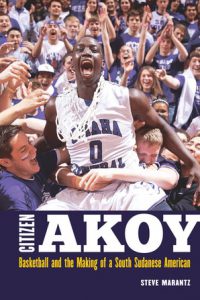 Citizen Akoy: Basketball and the Making of a South Sudanese American
Citizen Akoy: Basketball and the Making of a South Sudanese American
Akoy Agau led Omaha Central High School to four straight high school basketball state championships (2010–13) and was a three‑time All‑State player. One of the most successful high school athletes in Nebraska’s history, he’s also a South Sudanese refugee. At age four, Akoy and his family fled Sudan during the Second Sudanese Civil War, and after three years in Cairo, they came to Maryland as refugees. They arrived in Omaha in 2003 in search of a better future. In a fluid, intimate, and joyful narrative, Steve Marantz relates Akoy’s refugee journey of basketball, family, romance, social media, and coming of age at Nebraska’s oldest and most diverse high school. Set against a backdrop of the South Sudanese refugee community in Omaha, Marantz provides a compelling account of the power of sports to blend cultures in the unlikeliest of places.
Come Fly with Us: NASA’s Payload Specialist Program (Series: Outward 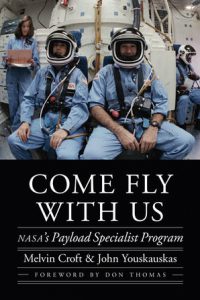 Odyssey: A People’s History of Spaceflight)
Odyssey: A People’s History of Spaceflight)
Come Fly with Us is the story of an elite group of space travelers who flew as members of many space shuttle crews from pre-Challenger days to Columbia in 2003. Not part of the regular NASA astronaut corps, these professionals known as “payload specialists” came from a wide variety of backgrounds and were chosen for an equally wide variety of scientific, political, and national security reasons. Melvin Croft and John Youskauskas focus on this special fraternity of spacefarers and their individual reflections on living and working in space. Relatively unknown to the public and often flying only single missions, these payload specialists give the reader an unusual perspective on the experience of human spaceflight. The authors also bring to light NASA’s struggle to integrate the wide-ranging personalities and professions of these men and women into the professional astronaut ranks.
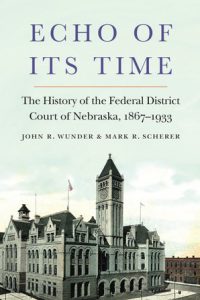 Echo of Its Time: The History of the Federal District Court of Nebraska, 1867-1933
Echo of Its Time: The History of the Federal District Court of Nebraska, 1867-1933
Throughout its existence the Federal District Court of Nebraska has echoed the dynamics of its time, reflecting the concerns, interests, and passions of the people who have made this state their home. Echo of Its Time explores the court’s development, from its inception in 1867 through 1933, tracing the careers of its first four judges: Elmer Dundy, William Munger, Thomas Munger (no relation), and Joseph Woodrough, whose rulings addressed an array of issues and controversies echoing macro-level developments within the state, nation, and world. Echo of Its Time both informs and entertains while using the court’s operations as a unique and accessible prism through which to explore broader themes in the history of the state and the nation. The book explores the inner workings of the court through Thomas Munger’s personal correspondence, as well as the court’s origins and growing influence under the direction of its legendary first judge, Elmer Dundy. Dundy handled many notable and controversial matters and made significant decisions in the field of Native American law, including Standing Bear v. Crook and Elk v. Wilkins. From the turn of the century through 1933 the court’s docket reflected the dramatic and rapid changes in state, regional, and national dynamics, including labor disputes and violence, political corruption and Progressive Era reform efforts, conflicts between cattle ranchers and homesteaders, wartime sedition and “slacker” prosecutions, criminal enterprises, and the endless battles between government agents and bootleggers during Prohibition.
Hearing Voices: Aurality and New Spanish Sound Culture in Sor Juana Inés 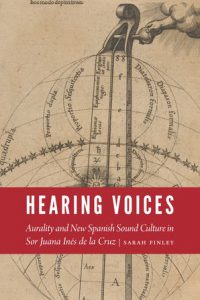 de la Cruz (Series: New Hispanisms)
de la Cruz (Series: New Hispanisms)
Hearing Voices takes a fresh look at sound in the poetry and prose of colonial Latin American poet and nun Sor Juana Inés de la Cruz (1648/51–95). A voracious autodidact, Sor Juana engaged with early modern music culture in a way that resonates deeply in her writing. Despite the privileging of harmony within Sor Juana’s work, however, links between the poet’s musical inheritance and subjects such as acoustics, cognition, writing, and visual art have remained unexplored. These lacunae have marginalized nonmusical aurality and contributed to the persistence of both ocularcentrism and a corresponding visual dominance in scholarship on Sor Juana—and indeed in early modern cultural production in general. Hearing Voices focuses on these aural conceits in highlighting the importance of sound and—in most cases—its relationship with gender in Sor Juana’s work and early modern culture. Sarah Finley explores attitudes toward women’s voices and music making; intersections of music, rhetoric, and painting; aurality in Baroque visual art; sound and ritual; and the connections between optics and acoustics. Finley demonstrates how Sor Juana’s striking aurality challenges ocularcentric interpretations and problematizes paradigms that pin vision to logos, writing, and other empirical models that traditionally favor men’s voices. Sound becomes a vehicle for women’s agency and responds to anxiety about the female voice, particularly in early modern convent culture.
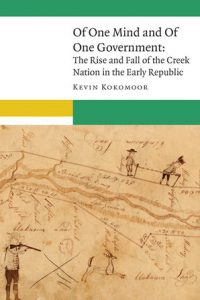 Of One Mind and Of One Government: The Rise and Fall of the Creek Nation in the Early Republic (Series: Early American Places, and, New Visions in Native American and Indigenous Studies)
Of One Mind and Of One Government: The Rise and Fall of the Creek Nation in the Early Republic (Series: Early American Places, and, New Visions in Native American and Indigenous Studies)
In Of One Mind and Of One Government Kevin Kokomoor examines the formation of Creek politics and nationalism from the 1770s through the Red Stick War, when the aftermath of the American Revolution and the beginnings of American expansionism precipitated a crisis in Creek country. The state of Georgia insisted that the Creeks sign three treaties to cede tribal lands. The Creeks objected vigorously, igniting a series of border conflicts that escalated throughout the late eighteenth century and hardened partisan lines between pro-American, pro-Spanish, and pro-British Creeks and their leaders. Creek politics shifted several times through historical contingencies, self-interests, changing leadership, and debate about how to best preserve sovereignty, a process that generated national sentiment within the nascent and imperfect Creek Nation.
Based on original archival research and a revisionist interpretation, Kokomoor explores how the state of Georgia’s increasingly belligerent and often fraudulent land acquisitions forced the Creeks into framing a centralized government, appointing heads of state, and assuming the political and administrative functions of a nation-state. Prior interpretations have viewed the Creeks as a loose confederation of towns, but the formation of the Creek Nation brought predictability, stability, and reduced military violence in its domain during the era.
One Size Fits None: A Farm Girl’s Search for the Promise of Regenerative 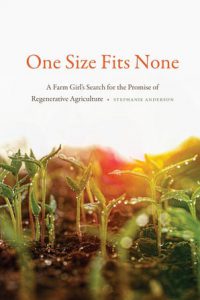 Agriculture
Agriculture
“Sustainable” has long been the rallying cry of agricultural progressives; given that much of our nation’s farm and ranch land is already degraded, however, sustainable agriculture often means maintaining a less-than-ideal status quo. Industrial agriculture has also co-opted the term for marketing purposes without implementing better practices. Stephanie Anderson argues that in order to provide nutrient-rich food and fight climate change, we need to move beyond sustainable to regenerative agriculture, a practice that is highly tailored to local environments and renews resources. In One Size Fits None Anderson follows diverse farmers across the United States: a South Dakota bison rancher who provides an alternative to the industrial feedlot; an organic vegetable farmer in Florida who harvests microgreens; a New Mexico super-small farmer who revitalizes communities; and a North Dakota midsize farmer who combines livestock and grain farming to convert expensive farmland back to native prairie. The use of these nontraditional agricultural techniques show how varied operations can give back to the earth rather than degrade it. This book will resonate with anyone concerned about the future of food in America, providing guidance for creating a better, regenerative agricultural future.
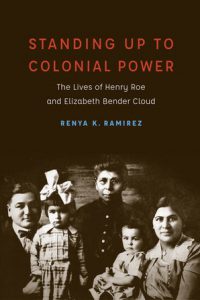 Standing Up to Colonial Power: The Lives of Henry Roe and Elizabeth Bender Cloud (Series: New Visions in Native American and Indigenous Studies)
Standing Up to Colonial Power: The Lives of Henry Roe and Elizabeth Bender Cloud (Series: New Visions in Native American and Indigenous Studies)
Standing Up to Colonial Power focuses on the lives, activism, and intellectual contributions of Henry Cloud (1884–1950), a Ho-Chunk, and Elizabeth Bender Cloud (1887–1965), an Ojibwe, both of whom grew up amid settler colonialism that attempted to break their connection to Native land, treaty rights, and tribal identities. Mastering ways of behaving and speaking in different social settings and to divergent audiences, including other Natives, white missionaries, and Bureau of Indian Affairs officials, Elizabeth and Henry relied on flexible and fluid notions of gender, identity, culture, community, and belonging as they traveled Indian Country and within white environments to fight for Native rights. Elizabeth fought against termination as part of her role in the National Congress of American Indians and General Federation of Women’s Clubs, while Henry was one of the most important Native policy makers of the early twentieth century. He documented the horrible abuse within the federal boarding schools and co-wrote the Meriam Report of 1928, which laid the foundation for the Indian Reorganization Act of 1934. Together they ran an early college preparatory Christian high school, the American Indian Institute. Standing Up to Colonial Power shows how the Clouds combined Native warrior and modern identities as a creative strategy to challenge settler colonialism, to become full members of the U.S. nation-state, and to fight for tribal sovereignty. Renya K. Ramirez uses her dual position as a scholar and as the granddaughter of Elizabeth and Henry Cloud to weave together this ethnography and family-tribal history.
Words Like Birds: Sakha Language Discourses and Practices in the City 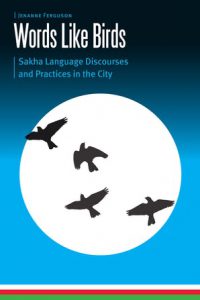 (Series: Borderlands and Transcultural Studies)
(Series: Borderlands and Transcultural Studies)
What does it mean to speak Sakha in the city? Words Like Birds, a linguistic ethnography of Sakha discourses and practices in urban far eastern Russia, examines the factors that have aided speakers in maintaining—and adapting—their minority language over the course of four hundred years of contact with Russian speakers and the federal power apparatus. Words Like Birds analyzes modern Sakha linguistic sensibilities and practices in the urban space of Yakutsk. Sakha is a north Siberian Turkic language spoken primarily in the Sakha Republic (Yakutia) in the northeastern Russian Federation. For Sakha speakers, Russian colonization in the region inaugurated a tumultuous history in which their language was at times officially supported and promoted and at other times repressed and discouraged. Jenanne Ferguson explores the communicative norms that arose in response to the top-down promotion of the Russian language in the public sphere and reveals how Sakha ways of speaking became emplaced in villages and the city’s private spheres. Focusing on the language ideologies and practices of urban bilingual Sakha-Russian speakers, Ferguson illuminates the changes that have taken place in the first two post-Soviet decades, in contexts where Russian speech and communicative norms dominated during the Soviet era. Weaving together three major themes—language ideologies and ontologies, language trajectories, and linguistic syncretism—this study reveals how Sakha speakers transform and adapt their beliefs, evaluations, and practices to revalorize a language, maintain and create a sense of belonging, and make their words heard in Sakha again in many domains of city life. Like the moveable spirited words, the focus of Words Like Birds is mobility, change, and flow, the tracing of the situation of bilinguals in Yakutsk.
Pictures and synopses courtesy of University of Nebraska Press.
What’s Up Doc? New State Agency Publications at the Nebraska Library Commission
 New state agency publications have been received at the Nebraska Library Commission for December 2018. Included are reports from a variety of Nebraska state agencies: Nebraska Department of Agriculture, Nebraska Board of Public Accountancy, Nebraska Workers’ Compensation Court, University of Nebraska-Lincoln Extension Service, University of Nebraska-Omaha Center for Applied Urban Research, and new books from the University of Nebraska Press, to name a few.
New state agency publications have been received at the Nebraska Library Commission for December 2018. Included are reports from a variety of Nebraska state agencies: Nebraska Department of Agriculture, Nebraska Board of Public Accountancy, Nebraska Workers’ Compensation Court, University of Nebraska-Lincoln Extension Service, University of Nebraska-Omaha Center for Applied Urban Research, and new books from the University of Nebraska Press, to name a few.
Most items, except the books from the University of Nebraska Press, are available for immediate viewing and printing by clicking on the highlighted link above, or directly in the .pdf below.
The Nebraska Legislature created the Nebraska Publications Clearinghouse in 1972, a service of the Nebraska Library Commission. Its purpose is to collect, preserve, and provide access to all public information published by Nebraska state agencies. By law (State Statutes 51-411 to 51-413) all Nebraska state agencies are required to submit their published documents to the Clearinghouse. For more information, visit the Nebraska Publications Clearinghouse page, contact Mary Sauers, Government Information Services Librarian, or contact Bonnie Henzel, State Documents Staff Assistant.
What’s Up Doc? New State Agency Publications at the Nebraska Library Commission
 New state agency publications have been received at the Nebraska Library Commission for October and November, 2018. Included are reports from a variety of Nebraska state agencies: Nebraska Auditor of Public Accounts, University of Nebraska-Lincoln Extension Service, Nebraska Legislative Research Office, Nebraska Department of Insurance, University of Nebraska State Museum, and new books from the University of Nebraska Press, to name a few.
New state agency publications have been received at the Nebraska Library Commission for October and November, 2018. Included are reports from a variety of Nebraska state agencies: Nebraska Auditor of Public Accounts, University of Nebraska-Lincoln Extension Service, Nebraska Legislative Research Office, Nebraska Department of Insurance, University of Nebraska State Museum, and new books from the University of Nebraska Press, to name a few.
Most items, except the books from the University of Nebraska Press, are available for immediate viewing and printing by clicking on the highlighted link above, or directly in the .pdf below.
The Nebraska Legislature created the Nebraska Publications Clearinghouse in 1972, a service of the Nebraska Library Commission. Its purpose is to collect, preserve, and provide access to all public information published by Nebraska state agencies. By law (State Statutes 51-411 to 51-413) all Nebraska state agencies are required to submit their published documents to the Clearinghouse. For more information, visit the Nebraska Publications Clearinghouse page, contact Mary Sauers, Government Information Services Librarian, or contact Bonnie Henzel, State Documents Staff Assistant.
Friday Reads: The Prague Sonata, by Bradford Morrow
 As a librarian and pianist, the minute I read the synopsis below for this book, I knew I had to read and listen to it. It is both a music mystery and literary mystery rolled into one. Bradford Morrow has done a masterful job of telling the story of not only the sonata, but of Prague’s tragic and triumphant history. I was hooked from beginning to end, and I think you will be too!
As a librarian and pianist, the minute I read the synopsis below for this book, I knew I had to read and listen to it. It is both a music mystery and literary mystery rolled into one. Bradford Morrow has done a masterful job of telling the story of not only the sonata, but of Prague’s tragic and triumphant history. I was hooked from beginning to end, and I think you will be too!
In the early days of the 21st century, pages of a worn and weathered original sonata manuscript – the gift of a Czech immigrant living out her final days in Queens – come into the hands of Meta Taverner, a young musicologist whose concert piano career was cut short by an injury. To Meta’s eye, it appears to be an authentic 18th-century work; to her discerning ear, the music rendered there is commanding, hauntingly beautiful, clearly the undiscovered composition of a master. But there is no indication of who the composer might be. The gift comes with the caveat that Meta attempts to find the manuscript’s true owner – a Prague friend the old woman has not heard from since the Second World War forced them apart – and to make the three-part sonata whole again. Leaving New York behind for the land of Dvorák and Kafka, Meta sets out on an unforgettable search to locate the remaining movements of the sonata and uncover a story that has influenced the course of many lives, even as it becomes clear that she isn’t the only one after the music’s secrets. (Audible.com)
Posted in Books & Reading, General, Uncategorized
Tagged "The Prague Sonata", Bradford Morrow, Friday Reads
Leave a comment
What’s Up Doc? New State Agency Publications at the Nebraska Library Commission
 New state agency publications have been received at the Nebraska Library Commission for September, 2018. Included are reports from a variety of Nebraska state agencies: Nebraska State Treasurer, University of Nebraska-Lincoln, Nebraska Coordinating Commission for Postsecondary Education, Nebraska Office of Probation Administration, Nebraska Supreme Court, and new books from the University of Nebraska Press, to name a few.
New state agency publications have been received at the Nebraska Library Commission for September, 2018. Included are reports from a variety of Nebraska state agencies: Nebraska State Treasurer, University of Nebraska-Lincoln, Nebraska Coordinating Commission for Postsecondary Education, Nebraska Office of Probation Administration, Nebraska Supreme Court, and new books from the University of Nebraska Press, to name a few.
All items, except the books from the University of Nebraska Press, are available for immediate viewing and printing by clicking on the highlighted link above, or directly in the .pdf below.
The Nebraska Legislature created the Nebraska Publications Clearinghouse in 1972, a service of the Nebraska Library Commission. Its purpose is to collect, preserve, and provide access to all public information published by Nebraska state agencies. By law (State Statutes 51-411 to 51-413) all Nebraska state agencies are required to submit their published documents to the Clearinghouse. For more information, visit the Nebraska Publications Clearinghouse page, contact Mary Sauers, Government Information Services Librarian, or contact Bonnie Henzel, State Documents Staff Assistant.
What’s Up Doc? New State Agency Publications at the Nebraska Library Commission
 New state agency publications have been received at the Nebraska Library Commission for July and August, 2018. Included are reports from a variety of Nebraska state agencies: Nebraska State Administrative Services, Nebraska Emergency Management Agency, Nebraska Game and Parks Commission, Nebraska State Historical Society, Nebraska State Patrol, and new books from the University of Nebraska Press, to name a few.
New state agency publications have been received at the Nebraska Library Commission for July and August, 2018. Included are reports from a variety of Nebraska state agencies: Nebraska State Administrative Services, Nebraska Emergency Management Agency, Nebraska Game and Parks Commission, Nebraska State Historical Society, Nebraska State Patrol, and new books from the University of Nebraska Press, to name a few.
All items, except the books from the University of Nebraska Press, are available for immediate viewing and printing by clicking on the highlighted link above, or directly in the .pdf below.
The Nebraska Legislature created the Nebraska Publications Clearinghouse in 1972, a service of the Nebraska Library Commission. Its purpose is to collect, preserve, and provide access to all public information published by Nebraska state agencies. By law (State Statutes 51-411 to 51-413) all Nebraska state agencies are required to submit their published documents to the Clearinghouse. For more information, visit the Nebraska Publications Clearinghouse page, contact Mary Sauers, Government Information Services Librarian, or contact Bonnie Henzel, State Documents Staff Assistant.
Friday Reads: Murphy’s Law, by Rhys Bowen
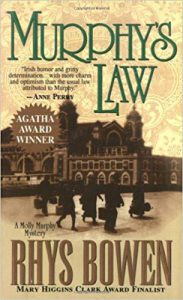 I have my mother-in-law to thank for introducing me to a new-to-me mystery series: The Molly Murphy Mysteries. So far, I’ve read and listened to Book 1: Murphy’s Law, and am halfway through Book 2: Death of Riley. This series is Mrs. Bowen’s third historical mysteries venture, and I am thoroughly enjoying it. Here’s a synopsis of Murphy’s Law:
I have my mother-in-law to thank for introducing me to a new-to-me mystery series: The Molly Murphy Mysteries. So far, I’ve read and listened to Book 1: Murphy’s Law, and am halfway through Book 2: Death of Riley. This series is Mrs. Bowen’s third historical mysteries venture, and I am thoroughly enjoying it. Here’s a synopsis of Murphy’s Law:
Murphy’s Law introduces us to the spunky, 19th-century Irish heroine: Molly Murphy. Defending herself from the unwelcome advances of a landowner’s son in Ireland, Molly accidentally kills him and flees to London to escape hanging. A split second decision introduces Molly to Kathleen O’Connor, who, with her two small children, has tickets on a ship to America, where she plans to join her husband. But after discovering she has tuberculosis, Kathleen persuades the desperate Molly to take her children to America. On board the ship, Molly attracts the loud attentions of a crude, boisterous type named O’Malley. Her public argument with him comes back to haunt her when he is found murdered on Ellis Island; Molly and a young man she befriended become prime suspects. Although the handsome young detective investigating the case, Daniel Sullivan, appears to believe Molly is innocent, Molly decides she’d better investigate on her own behalf and that of her friend. Wending her way through a gritty, pulsating underworld of recently arrived immigrants in Tammany Hall-era New York, Molly struggles to prove her innocence by any means necessary.
Complete list of the Molly Murphy series titles:
- Murphy’s Law (2001)
- Death of Riley (2002)
- For the Love of Mike (2003)
- In Like Flynn (2005)
- Oh Danny Boy (2006)
- In Dublin’s Fair City (2007)
- Tell Me, Pretty Maiden (2008)
- In a Gilded Cage (2009)
- The Last Illusion (2010)
- Bless the Bride (2011)
- Hush Now, Don’t You Cry (2012)
- The Family Way (2013)
- City of Darkness and Light (2014)
- The Edge of Dreams (2015)
- Away in a Manger (2015)
- Time of Fog and Fire (2016)
- The Ghost of Christmas Past (2017)
